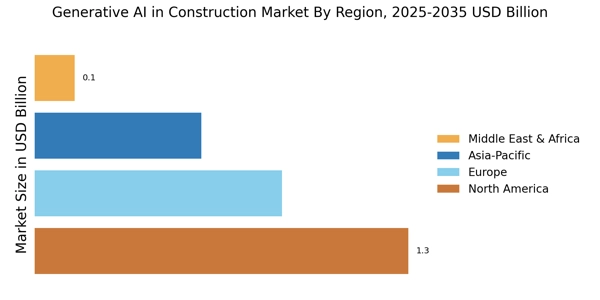Improved Safety Protocols
Safety remains a paramount concern in the construction sector, and the Generative AI in Construction Market is addressing this through advanced predictive analytics. Generative AI can analyze vast amounts of data to identify potential hazards and suggest preventive measures. For example, AI systems can predict accident hotspots on construction sites, potentially reducing workplace injuries by 20%. This proactive approach not only enhances worker safety but also minimizes project delays caused by accidents. As safety regulations become more stringent, the adoption of generative AI technologies is expected to rise, reinforcing its role in creating safer construction environments.
Enhanced Collaboration and Communication
Collaboration is critical in construction projects, and the Generative AI in Construction Market is facilitating improved communication among stakeholders. AI-driven platforms enable real-time data sharing and collaboration, which can lead to better decision-making and fewer misunderstandings. For instance, generative AI tools can integrate inputs from architects, engineers, and contractors, streamlining the design and construction process. This enhanced collaboration can potentially reduce rework by 15%, thereby saving time and resources. As the industry continues to evolve, the role of generative AI in fostering effective communication is expected to expand, making it an essential component of modern construction practices.
Increased Efficiency in Project Management
The Generative AI in Construction Market is witnessing a surge in demand for tools that enhance project management efficiency. By automating routine tasks and optimizing workflows, generative AI solutions can significantly reduce project timelines. For instance, studies indicate that AI-driven project management tools can decrease project delivery times by up to 30%. This efficiency not only leads to cost savings but also allows construction firms to take on more projects simultaneously, thereby increasing their market share. As the industry continues to embrace digital transformation, the integration of generative AI is likely to become a standard practice, further driving its adoption in project management.
Customization and Personalization of Designs
The Generative AI in Construction Market is revolutionizing design processes by enabling high levels of customization and personalization. Generative AI algorithms can analyze user preferences and site conditions to create tailored design solutions that meet specific project requirements. This capability not only enhances aesthetic appeal but also improves functionality and sustainability. Market data indicates that projects utilizing generative design can achieve up to 40% more efficient use of materials. As clients increasingly demand unique and innovative designs, the adoption of generative AI in the design phase is likely to become a key differentiator for construction firms, driving growth in the industry.
Cost Reduction through Predictive Maintenance
The Generative AI in Construction Market is increasingly focused on predictive maintenance, which can lead to substantial cost reductions. By utilizing AI algorithms to analyze equipment performance data, construction firms can anticipate failures before they occur, thereby avoiding costly downtime. Reports suggest that predictive maintenance can reduce maintenance costs by up to 25%. This capability allows companies to allocate resources more effectively and extend the lifespan of their equipment. As the construction industry grapples with rising operational costs, the integration of generative AI for maintenance purposes is likely to gain traction, enhancing overall profitability.


















Leave a Comment